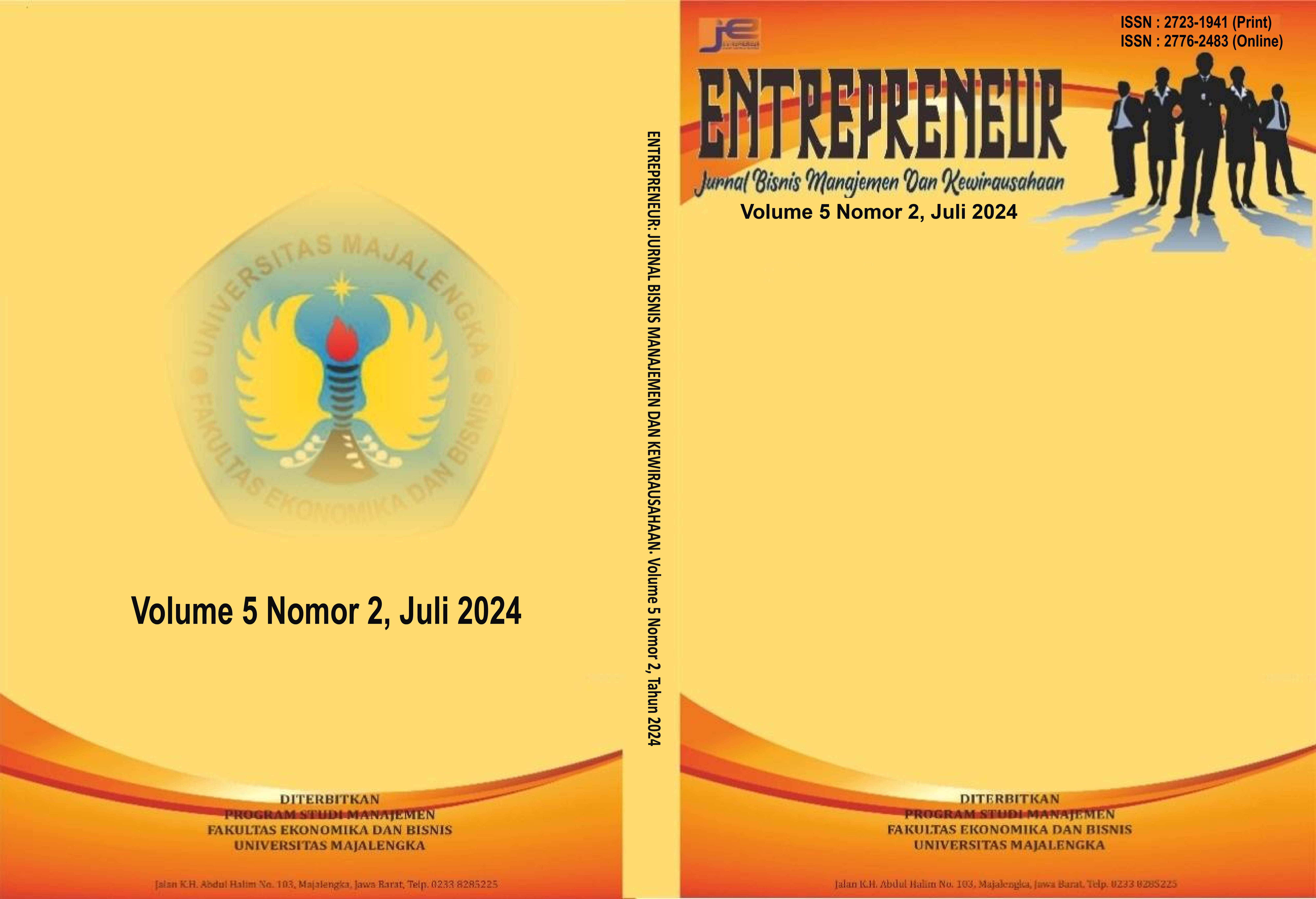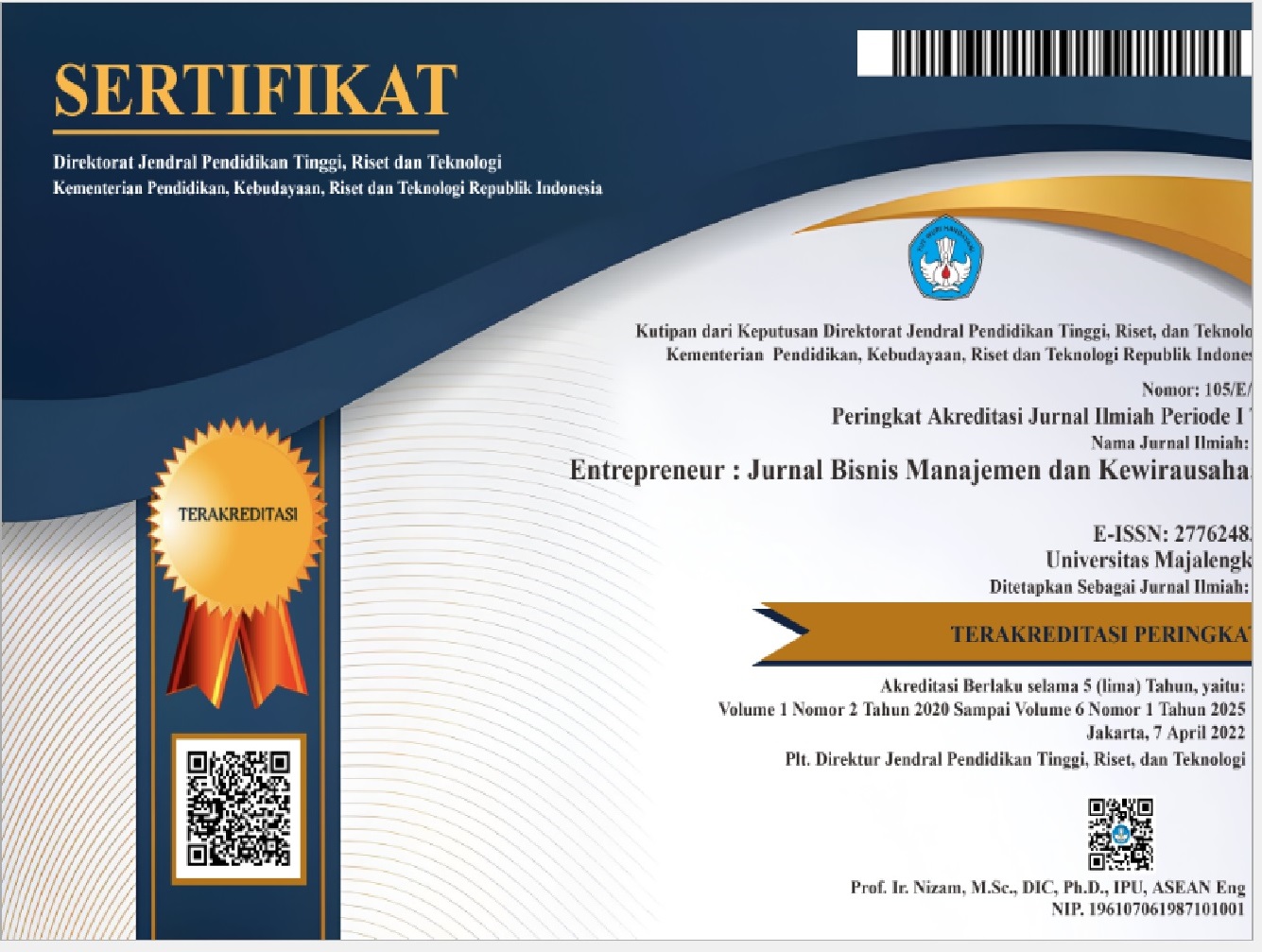Analisis Kualitas Pelayanan Dengan Menggunakan Metode Servqual (Studi Kasus Internet Service Provider PT Giandra Saka Media)
DOI:
https://doi.org/10.31949/entrepreneur.v5i2.7124Abstract
Customer satisfaction is something that is very important for service companies. This research aims to measure customer satisfaction with the Internet Service Provider PT Giandara Saka Media (Gisaka Media). The method used in this research is the Servqual method and the Cartesian diagram model. In general, the quality of service at the Internet Service Provider PT Giandara Saka Media (Gisaka Media) still does not fully meet customer expectations, because the gap value for each dimension is still negative (-), the largest gap is in the Assurance Dimension and the smallest is in the Empathy dimension.
The Assurance dimension must be given special attention in improving services, especially services in terms of guarantees that services will run without significant disruption, guarantees of suitability of services to what is advertised and compliance with contracts with customers and network availability. If ISPs want to develop further and still be able to retain existing customers, then service quality in all dimensions must be immediately improved, especially in the assurance dimension
Keywords:
customer satisfaction, service quality, consumer expectationsDownloads
References
Buchari Alma. 2007. Mananjemen Pemasaran dan Pemasaran Jasa. Alfabeta. Bandung.
Duffy, Bobby et.al. Measuring ang Understanding Cotumer Satisfaction. Dalam Mori review for Office of the Publik Service Reform.
Fandy Tjiptono, 1997. Strategi Pemasaran. Edisi ke Dua. CV. Andi Offset. Jakarta.
Fandy Tjiptono. 1996. Manajemen Jasa. Andi. Yogyakarta.
Fandy Tjiptono. 2007, “Service Quality & Satisfaction”, Edisi Kedua, Andi. Karangwaru.
Hadari Nawawi. 2001. Manajemen Sumber Daya Manusia Untuk Bisnis Yang Kompetitif. Penerbit PT. Gadjah Mada University Press. Yogyakarta.
Harun Al Rasyid. 1994. Tehnik Penarikan Sampel dan Pengukuran Skala. Program Pascasarjana Universitas Padjadjaran. Bandung.
Husen Umar. 2003, “Riset Pemasaran & Perilaku Konsumen”, PT. Gramedia Pustaka Utama. Jakarta.
Istijanto. 2009, ”Aplikasi Praktis Riset Pemasaran”, Cetakan Kedua, Penerbit PT. Gramedia Pustaka Utama. Jakarta.
J. Supranto. 1997. Pengukuran Tingkat Kepuasan Pelanggan Untuk Menaikan Pangsa Pasar. Penerbit PT. Rineka Cipta. Jakarta
Kotler, Philip. 1993, Manajemen Pemasaran, Analisis, Perencanaan, Implementasi, dan Pengendalian, edisi ke tujuh, volume dua, Lembaga Fakultas Ekonomi, Universitas Majalengka.
Kotler, Philip. 1994. Marketing Management. Indeks. Jakarta.
Kotler, Philip. 2000. Manajemen Pemasaran, Analisis, Perencanaan, Implementasi dan Kontrol, Milenium Jilid I dan II Revisi, Edisi ke 10 edisi Bahasa Indonesia. Alih Bahasa Hendra Teguh, SE …Ak dan Ronny A Ruli, SE..AK. Penerbit PT. Prenhallindo. Jakarta.
Lupiyoadi. 2001. Manajemen Pemasaran Jasa. Salemba. Jakarta.
Munijati Munawaroh. 2000. Analisis Pengaruh Kualitas Jasa Terhadap Kepuasan Pada Industri Pendidikan Di Yogyakarta. Jurnal Siasat Bisnis, Edisi 5 Vol 2
Narbuko Cholid dan H. Abu Achmadi. 2005. Metodelogi Penelitian. Penerbit PT Bumi Aksara. Jakarta.
Parasuraman et.al. 1988. Servqual : A Multiple-Item Scale for Measuring Costumer Perception of Service Quality. Journal of Retailing.
Renny Sri Purwanti. 2009. Analisis Kualitas Pelayanan Sebagai Dasar Peningkatan Kepuasan Pelanggan. Wawasan Tridharma.
Sugiono. 2007. Metodologi Penelitian Bisnis. CV Alfabeta. Bandung..
Wahyu Ariani D. Pengendalian Kualitas Statistik (Pendekatan Kuantitatif dalam Manajeman Kualitas). Andi Offset. Yogyakarta.
Yunianto Tri Atmojo. 2006. Mengukur Kepuasan Konsumen. http://triatmojo.wordpress.com.

Published
How to Cite
Issue
Section
License
Copyright (c) 2024 Gilang Bhirawa Noraga, Dadang Sudirno, Hani Sri Mulyani

This work is licensed under a Creative Commons Attribution-ShareAlike 4.0 International License.
COPYRIGHT NOTICE
An author who publishes in the Entrepreneur: Jurnal Bisnis Manajemen dan Kewirausahaan agrees to the following terms:
1. Author retains the copyright and grants the journal the right of first publication of the work simultaneously licensed under the Creative Commons Attribution-ShareAlike 4.0 License that allows others to share the work with an acknowledgment of the work's authorship and initial publication in this journal
2. The author is able to enter into separate, additional contractual arrangements for the non-exclusive distribution of the journal's published version of the work (e.g., post it to an institutional repository or publish it in a book) with the acknowledgment of its initial publication in this journal.
3. The author is permitted and encouraged to post his/her work online (e.g., in institutional repositories or on their website) prior to and during the submission process, as it can lead to productive exchanges, as well as earlier and greater citation of the published work







